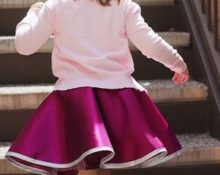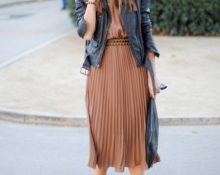 The skirt is considered one of the most ancient items of clothing. Its likeness was worn by primitive people, and ancient frescoes tell us that in ancient cultures such an outfit was widespread everywhere. In Egypt, for example, the length of a skirt could indicate the origin and status of its owner.
The skirt is considered one of the most ancient items of clothing. Its likeness was worn by primitive people, and ancient frescoes tell us that in ancient cultures such an outfit was widespread everywhere. In Egypt, for example, the length of a skirt could indicate the origin and status of its owner.
Over time, these clothes changed length, styles and even gender. Below is a short excursion into the history of this clothing.
What kind of clothing item is a skirt?
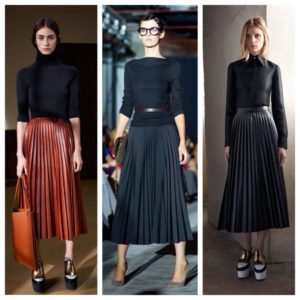 In explanatory dictionaries, two dictionary entries are given for the word “skirt”. In one case it is defined as the part of a woman's dress from the waist to the hem, inseparable from the bodice. However, we will be interested in the second case, where a skirt is defined as a separate item of clothing, usually for women, starting from the waist and covering the hips. The length can vary from micro, which only slightly covers the upper thigh, to floor length.
In explanatory dictionaries, two dictionary entries are given for the word “skirt”. In one case it is defined as the part of a woman's dress from the waist to the hem, inseparable from the bodice. However, we will be interested in the second case, where a skirt is defined as a separate item of clothing, usually for women, starting from the waist and covering the hips. The length can vary from micro, which only slightly covers the upper thigh, to floor length.
Meaning of the word
 The word “skirt” has come a long way before it appeared in Russia in its true meaning.Its root is in Arabic (jubba - outerwear, sleeveless jacket); through Old French and Old Italian, where the word was slightly modified without losing its meaning (iupe - outerwear), it came to Polish (jupka), from where it came to Russia already in the 16th century.
The word “skirt” has come a long way before it appeared in Russia in its true meaning.Its root is in Arabic (jubba - outerwear, sleeveless jacket); through Old French and Old Italian, where the word was slightly modified without losing its meaning (iupe - outerwear), it came to Polish (jupka), from where it came to Russia already in the 16th century.
Today this word in the Russian language has “retained” only one meaning – predominantly women’s clothing from the waist to the hem, covering the hips and legs together.
Historical reference
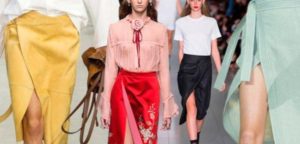 The evolution of this wardrobe detail, fashionable today, began literally in antediluvian times. Any schoolchild knows that ancient people covered their nakedness with palm leaves, and in later times they wrapped animal skins around their hips, thus creating a kind of modern skirt.
The evolution of this wardrobe detail, fashionable today, began literally in antediluvian times. Any schoolchild knows that ancient people covered their nakedness with palm leaves, and in later times they wrapped animal skins around their hips, thus creating a kind of modern skirt.
Until the 20th century, this item of clothing only changed in width and shape. In Rus', women wore ponevs and scaffolds; noble townswomen wore long swinging dresses, which were richly decorated. Only after the reforms of Peter I in 1700, noble ladies and girls had to dress in clothes of European styles.
Appearing as a separate element of clothing in the 15th century, when the lower part of the dress was separated from the bodice, skirts went through several stages in their development. Let us briefly list their most basic types and characteristics:
 from the 15th century, a long skirt with soft pleats (gamurra) traveled from Italy throughout Europe for a century;
from the 15th century, a long skirt with soft pleats (gamurra) traveled from Italy throughout Europe for a century;- in the 16th century, noble Spanish women with skirts on verdugos frames took over the baton from Italian women; they were attached to the corset and were heavy in themselves, and when combined with a richly decorated outerwear, wearing it turned into a real feat - after all, you also had to dance in it;
- in the 17th century, French women banished hoops and corsets from fashion, the skirt became soft and flowed freely, but by the end of the century, hoops and trains again began to determine its shape;
- in the 18th century, panniers appeared, which in Russia were called figmas - frames made of whalebone, metal or willow twigs, they made this item of ladies' clothing more magnificent than ever before in history; the emphasis moved from the upper skirt to the lower one, which was decorated with flounces and lace and had to peek out from under the upper one;
- in the 19th century corsets and petticoats come again; the fabric from which they were made should not be bright, it was considered indecent.
At the end of the century there appeared crinoline - a skirt made of rigid fabric based on horsehair, and later underskirts on frames began to be called this. In the 20th century, with the advent of newfangled dances, this item of clothing became shorter and shorter, and by the 60s, Mary Quant created a mini.
What is the length?
The classification of length in the most general terms looks like this:
 the same mini, about 15 cm long above the knee; preferable for young girls and women with slender legs;
the same mini, about 15 cm long above the knee; preferable for young girls and women with slender legs;- knee-length - unfairly considered old-fashioned today, in the “correct” ensemble it looks very elegant; preferable for women over 35 years old and business women;
- French length - a skirt 15–20 cm below the knee, is at the peak of popularity; the length is almost universal, the only limitation is full calves;
- maxi – ankle length; is universal, as it allows you to hide many figure flaws.
A variety of maxi can be called the current floor length, an indispensable participant in fashion shows. Popular with both young ladies and mature women.
Skirt styles
 One of the most popular models is the pencil skirt. Straight, tapering downwards, length from mini to French. It can be easily combined with clothes of various styles and is loved by almost all representatives of the fair sex, from a strict boss to a young schoolgirl.
One of the most popular models is the pencil skirt. Straight, tapering downwards, length from mini to French. It can be easily combined with clothes of various styles and is loved by almost all representatives of the fair sex, from a strict boss to a young schoolgirl.- The circle skirt has not gone out of fashion for many years, changing only the length and the material from which it is made. The peculiarity of the cut (in a circle), creating soft folds, allows you to hide figure imperfections, while creating a feminine silhouette. And finding companions for her will not be difficult. A type of circle skirt is a tutu, or tutu, which is sewn from lightweight fabrics, thereby creating additional volume..
 Floor-length is not only the length, but also a unique style that creates romantic looks. Made from chiffon or leather, knitwear or tulle, they will always find their fans. By hiding flaws, while adding mystery to a woman, they allow her to feel confident and free.
Floor-length is not only the length, but also a unique style that creates romantic looks. Made from chiffon or leather, knitwear or tulle, they will always find their fans. By hiding flaws, while adding mystery to a woman, they allow her to feel confident and free.- Godet is a long-term friend of beautiful ladies. Tapering to the knee and flaring at the bottom, it will highlight feminine shapes, give a graceful silhouette and easily adapt to your mood, easily combining with your favorite things.
- The A-line skirt is universal. A simple A-line cut that flares out at the bottom creates a cute, feminine look. Perfect for everyday wear, as it can easily be combined with both sports and classic clothes.
Men's skirt - what is it?
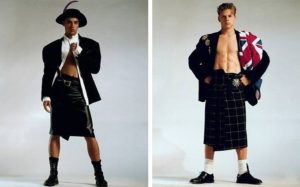 Initially having no gender, over time this item of clothing migrated exclusively to women’s wardrobes, remaining in men’s folk costumes as a tribute to national traditions.
Initially having no gender, over time this item of clothing migrated exclusively to women’s wardrobes, remaining in men’s folk costumes as a tribute to national traditions.
Today the situation is changing and men in this outfit allow themselves to shock society. Some fashion designers have created special lines of fashionable men's skirts, and this piece of clothing is gradually ceasing to be a purely feminine attribute.


 from the 15th century, a long skirt with soft pleats (gamurra) traveled from Italy throughout Europe for a century;
from the 15th century, a long skirt with soft pleats (gamurra) traveled from Italy throughout Europe for a century; the same mini, about 15 cm long above the knee; preferable for young girls and women with slender legs;
the same mini, about 15 cm long above the knee; preferable for young girls and women with slender legs;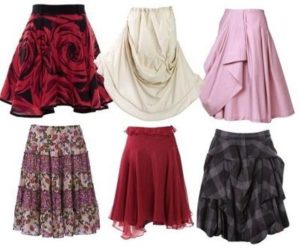 One of the most popular models is the pencil skirt. Straight, tapering downwards, length from mini to French. It can be easily combined with clothes of various styles and is loved by almost all representatives of the fair sex, from a strict boss to a young schoolgirl.
One of the most popular models is the pencil skirt. Straight, tapering downwards, length from mini to French. It can be easily combined with clothes of various styles and is loved by almost all representatives of the fair sex, from a strict boss to a young schoolgirl.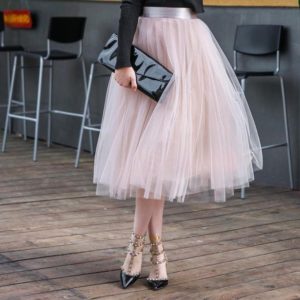 Floor-length is not only the length, but also a unique style that creates romantic looks. Made from chiffon or leather, knitwear or tulle, they will always find their fans. By hiding flaws, while adding mystery to a woman, they allow her to feel confident and free.
Floor-length is not only the length, but also a unique style that creates romantic looks. Made from chiffon or leather, knitwear or tulle, they will always find their fans. By hiding flaws, while adding mystery to a woman, they allow her to feel confident and free. 0
0


